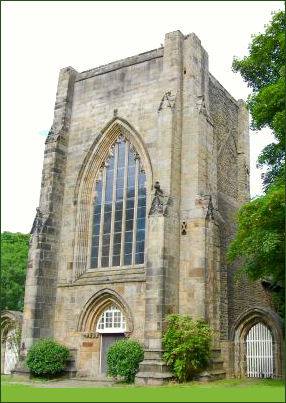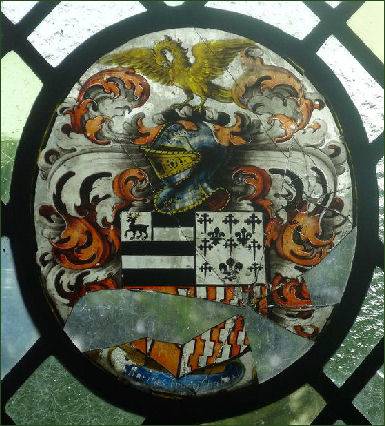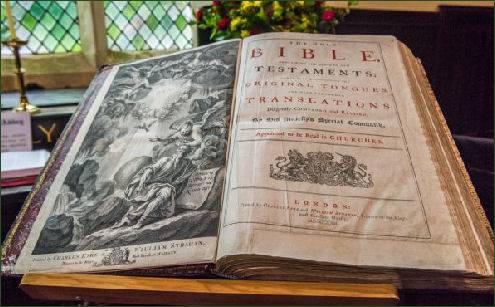Beauchief Abbey
OS grid reference:- SK 333 819
 Beauchief Abbey is a medieval monastic house now serving as a parish church in the southern suburbs of Sheffield. The Abbey is a place of learning, celebration, worship, history, heritage and community.
Beauchief Abbey is a medieval monastic house now serving as a parish church in the southern suburbs of Sheffield. The Abbey is a place of learning, celebration, worship, history, heritage and community.
Beauchief Abbey was founded as a daughter establishment of Welbeck Abbey, due to a gift of land by Robert FitzRanulph, Lord of Alfreton, in about 1176. Thomas Tanner, writing in 1695, stated that it was founded in 1183. However, Samuel Pegge in his History of Beauchief Abbey noted that Albinas, the abbot of Derby, who was one of the witnesses to the charter of foundation, died in 1176, placing foundation before that date. It was dedicated to "God and St Mary and St Thomas the Martyr and to the brothers of the Premonstratensian order". Archbishop Thomas Becket was murdered in 1170 and was canonized in 1173. Tanner stated that Robert FitzRanulf was one of the murderers of Thomas Becket and founded the abbey to expiate his guilt. Pegge also disputed this fact, showing that Robert FitzRanulf had no connection with the murder.
 The Premonstratensian order was founded in 1120 at Prémontré in France. Its members were canons (known as White Canons) rather than monks. Usually, between 12 and 15 of them lived at the Abbey, but as ordained priests they also worked in local communities, some taking charge of nearby churches. FitzRanulph granted the churches of Norton, Alfreton, Wymeswold, and Adwalton to the Abbey, and a further grant of Dronfield church was made in 1399. In addition to this, the Abbey owned a number of outlying farms or "granges" as well as four or five mills and a smithy on the Sheaf.
Records of the lands held by the Abbey were copied by the canons into a book known as the "Cartulary". This book, in its original binding, is held in the Archives of Sheffield City Council. It
The Premonstratensian order was founded in 1120 at Prémontré in France. Its members were canons (known as White Canons) rather than monks. Usually, between 12 and 15 of them lived at the Abbey, but as ordained priests they also worked in local communities, some taking charge of nearby churches. FitzRanulph granted the churches of Norton, Alfreton, Wymeswold, and Adwalton to the Abbey, and a further grant of Dronfield church was made in 1399. In addition to this, the Abbey owned a number of outlying farms or "granges" as well as four or five mills and a smithy on the Sheaf.
Records of the lands held by the Abbey were copied by the canons into a book known as the "Cartulary". This book, in its original binding, is held in the Archives of Sheffield City Council. It
The Dissolution of the Monasteries under King Henry VIII saw an end to medieval church life at the Abbey, and on 4 February 1537 it was surrendered to Thomas Cromwell's commissioners.
Sir Nicholas Strelley, then Lord of Ecclesall, purchased the Abbey and all the land in the Liberty of Beauchief for £223. In 1648 the land came by marriage into the possession of the Pegge family. Following the Dissolution, the church fell into disrepair, but it seems (on the basis of excavations conducted in the 1920's) that some of the other buildings, including the chapter house and the refectory, continued to be used, the first as a lumber store and wine cellar the second as a residence. At least from 1667 onwards, however, much of the stone was used for the building of Beauchief Hall, which became the residence of Edward Pegge in 1671.
At about this time or later, the nave of the church and the tower were at least partially restored to make a chapel for the landowners, as can be seen today in the surviving box pews, coats of arms, and carved stone memorials. Nathaniel Baxter was appointed the first chaplain in 1662, and the gravestones on the floor of the chapel include two by the altar which are dated 1659 and 1660. This suggests that the chapel had started functioning by that time, although Tony Smith argues that it did not assume its present form until the middle of the eighteenth century.
 The Pegge family continued to own Beauchief Hall and the Abbey until 1922, when they were sold respectively
to Major Wilson and to Mr. Frank Crawshaw. In 1931 he sold the land occupied today by Beauchief Golf Course to the Sheffield Corporation. At the same time Mr. Crawshaw offered the Abbey, adjacent cottages, graveyard and Abbey grounds as a gift to the Corporation, for the Citizens of Sheffield, on certain conditions which, after modification, were accepted. The Abbey was declared to be a scheduled monument in 1957 but it remains in the ownership of the Council.
The Pegge family continued to own Beauchief Hall and the Abbey until 1922, when they were sold respectively
to Major Wilson and to Mr. Frank Crawshaw. In 1931 he sold the land occupied today by Beauchief Golf Course to the Sheffield Corporation. At the same time Mr. Crawshaw offered the Abbey, adjacent cottages, graveyard and Abbey grounds as a gift to the Corporation, for the Citizens of Sheffield, on certain conditions which, after modification, were accepted. The Abbey was declared to be a scheduled monument in 1957 but it remains in the ownership of the Council.
Today only the western tower of the Abbey, flanked by a pair of Gothic archways, remains attached to a chapel which was built in the seventeenth century, but what remains is a Scheduled Ancient Monument. The foundations of other buildings are visible and the medieval fishponds still exist.
Much of the old estate is now occupied by two golf courses (Abbeydale Golf Club and Beauchief Golf Club), but several areas of ancient woodland remain: Parkbank Wood to the East of the Abbey, Old Park Wood and Little Wood Bank to the south, Gulleys Wood in the centre of the park and Ladies Spring Wood to the west.
Public footpaths run through the estate, including across the golf courses and through several of the woods. The Sheffield Round Walk arrives from Park Bank Wood, running eastwards through Chancet Wood and on to Graves Park. Ladies Spring Wood (also known as Totley Wood is an arc-shaped area of mature deciduous woodland on a steep bank facing the River Sheaf to the west. It was formerly managed for coppicing with standards-the remains of charcoal platforms and q-pits are still to be found here. It is currently managed by Sheffield City Council for wildlife and public recreation, and has two public footpaths running through. The trees today are mainly sessile oak, with birch and rowan on the upper slopes and ash and alder on the lower slopes and on the river terrace, with small numbers of other species also represented. The upper terrace is dominated by rhododendrons. The wood supports many birds, including dippers by the river and several species of hole-nesting birds including all the nuthatch, the green woodpecker, the great spotted woodpecker and the lesser spotted woodpecker.
There is significant evidence that this is primary ancient woodland, including: The name: Spring is Anglo-Saxon for coppicing, indicating that the wood existed and was managed for coppicing many hundreds of years ago. The wood's edge has several bends and zig-zags, characteristic of the surrounding land being cleared over a long period of time. The River Sheaf on its western border used to be the boundary between the parishes of Sheffield and Norton; and formerly the boundary between Yorkshire and Derbyshire; and before that, the boundary between the Anglo-Saxon states of Mercia and Northumbria. Woodland on such boundaries is often left undeveloped. The absence of evidence of early settlements or field boundaries. It has been designated a Site of Special Scientific Interest for its biological interest, under the name "Totley Wood".
Parkbank Wood is also an old mature wood, though it has seen more active use in the past and may not be primary ancient woodland. There is again evidence of charcoal and white coal manufacture in the form of charcoal hearths and Q-pits, and also evidence of former quarrying and boundary ditches, which may indicate that the area was at one time cleared for agriculture.This is also now mostly mature sessile oak, and has public footpaths granting access, including the Sheffield Round Walk. The parkland, though it has had its topography altered for the golf courses, still includes evidence of mediaeval ridge and furrow farming
